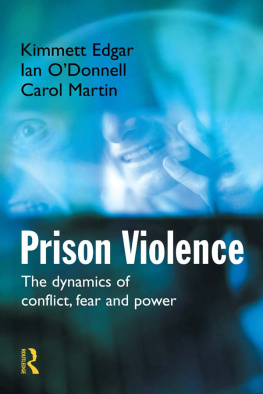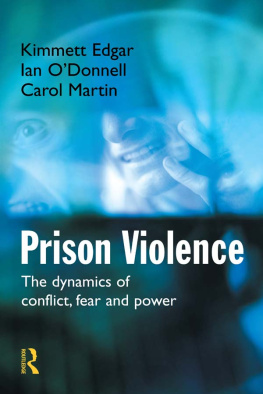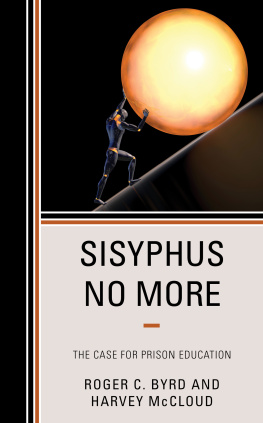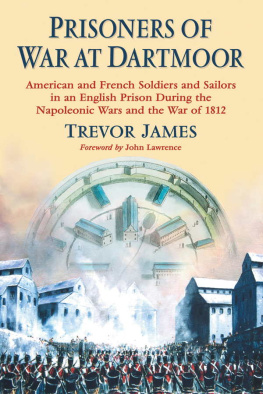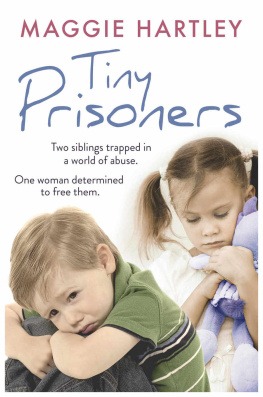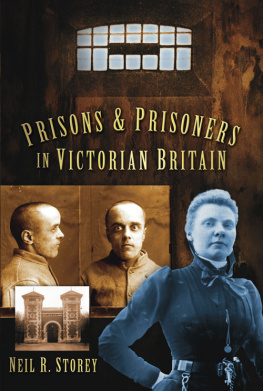Prison Violence
The Dynamics of Conflict, Fear and Power
Kimmett Edgar, Ian O'Donnell and Carol Martin
First published by Willan Publishing 2003
This edition published by Routledge 2011
2 Park Square, Milton Park, Abingdon, Oxon OX14 4RN
711 Third Avenue, New York, NY 10017
Routledge is an imprint of the Taylor & Francis Group, an informa business
First issued in paperback 2012
Kimmett Edgar, Ian O'Donnell and Carol Martin 2003
The rights of Kimmett Edgar, Ian O'Donnell and Carol Martin to be identified as the authors of this book have been asserted by them in accordance with the Copyright, Designs and Patents Act of 1988.
All rights reserved; no part of this publication may be reproduced, stored in a retrieval system, or transmitted in any form or by any means, electronic, mechanical, photocopying, recording or otherwise without the prior written permission of the Publishers or a licence permitting copying in the UK issued by the Copyright Licensing Agency Ltd, 90 Tottenham Court Road, London W1P 9HE.
ISBN 978-1-903240-98-4 (hbk)
ISBN 978-0-415-62794-8 (pbk)
British Library Cataloguing-in-Publication Data
A catalogue record for this book is available from the British Library
Typeset by TW Typesetting, Plymouth, Devon
Project management by Deer Park Productions, Tavistock, Devon
Kimmett Edgar is Research Manager, Prison Reform Trust and formerly Senior Research Officer at the University of Oxford Centre for Criminological Research.
Ian O'Donnell is Research Fellow at the Institute of Criminology, Faculty of Law, University College Dublin, and an Associate of the University of Oxford Centre for Criminological Research.
Carol Martin was formerly Research Officer at the University of Oxford Centre for Criminological Research.
We are grateful to the prisoners whose views and experiences form the heart of this book. We hope that we have properly reflected their concerns about prison safety. We are obliged also to the governors and staff who made us welcome and facilitated our tasks. In each establishment we visited, we were received with courtesy and enthusiasm. Our work was supported at every stage by Prison Service Headquarters.
The first of the two projects that form the core of this book was funded by the Home Office Research and Statistics Directorate and the second by the Economic and Social Research Council under its Violence Research Programme. We acknowledge these sponsors with thanks and are pleased to have been supported by them while we carried out our work. are based on the study commissioned by the Home Office. The views expressed are those of the authors and not necessarily the Home Office (nor do they reflect government policy).
The University of Oxford Centre for Criminological Research, where we all worked at various stages over the past decade, provided the necessary administrative support as well as a congenial and stimulating work environment. A special word of thanks is reserved for Professor Roger Hood, Director of the Centre and Fellow of All Souls College, who oversaw both research projects from conception to completion. Professor Hood was always unstinting in his support, generous with his time and constructive with his comments. The successive drafts of this book have benefited greatly from his insightful guidance and academic rigour. In addition, he ensured that Kimmett Edgar could devote sufficient time to the completion of this book.
We would also like to thank Dr Diego Gambetta, Reader in Sociology at Oxford University and Fellow of All Souls College, for his comments on the penultimate draft of our manuscript. Ian O'Donnell acknowledges the generosity of University College Dublin, which made possible his contribution to the writing of this book, through the grant of a President's Research Award.
Kimmett Edgar, Ian O'Donnell and Carol Martin
July 2002
Stewkley
I'm in his cell and I'm talking to him. We were talking sensibly. Then a mate of mine comes in and grabs my arm and tries to pull me out. As the door opens, there were loads of heads there and that must have made him change his mind he started saying, Get out! What you doing there, you little monkey? and he started pushing me. He threw me out like I was a rag doll, and I thought that was humiliating, so I retaliated by punching him in the face. He picked me up and steamed me into the wall. I said to myself, He's big but he's slow. He's still trying to grapple with me I'm still hitting him to the head and face. I was upset because I didn't want to resort to that over something so trivial. I don't remember it at all but he fell down and I carried on kicking him. I heard the alarm bell and my friend pulled me out and I went into his cell and washed my face and got some of the blood off. I was hoping the officers wouldn't know who was fighting but they came for me and took me down the Block. They started to tell me it was assault but when I mentioned my solicitor, they said they would do me for fighting.
Warslow
I saw Stewkley come up the stairs and he came in my cell and pushed the door to. He starts being abusive to me. The way he was stood side on and his hand kept going towards his pocket I said, You're tooled up, are you? I called him a kid and told him to get out. I'd avoid a confrontation if possible unless I'm being hit. I told him to get out but he had his foot against the door. I wanted him out of the cell, so I put my hands on his shoulders and moved him to the side through the door. As he went through the door, he swung his hand round and punched me in the face he knocked my front tooth out. I put my hands back on his
shoulders to push him out. He tried to hit me again but he grabbed my shirt and I tripped over. Whilst I was on the floor, he kicked me three times in the face. An officer was there and shouted and it just broke up. He knew something was going on. Stewkley went into his friend's cell and I went into my cell. Staff came in straight away and said I had been assaulted. I then made a statement and signed it but I don't know why I got charged with fighting. I was taken to Health Care and then the Block.
The harm caused by imprisonment is multifaceted. Most evident are the material deprivations of prison life, isolation from families and reduced prospects for future employment. In addition to these, the prisoner runs the risk of becoming a victim of crimes such as theft, robbery or assault; and more rarely, rape or murder. Violent incidents, such as the fight between Stewkley and Warslow, seem to confirm a stereotype of prisoners as volatile and dangerous individuals. Our aim is to explain the nature and extent of interpersonal prison violence and victimization; that is, incidents that arise between individual prisoners, including fights and assaults, but also threats, robberies and bullying. We will not deal with the uses of force in relations between prisoners and prison officers, nor will we discuss collective violence, such as rioting or destructive demonstrations.
This book brings together evidence from two major pieces of research on prison life (both conducted in England and Wales). The first, the victimization study, focused primarily on the extent of different forms of harmful behaviour, ranging from assaults with weapons to social exclusion. It was funded by the Home Office Research and Statistics Directorate (as it was then). The second, the conflicts study, grew out of the first. It gathered detailed information about the tactics prisoners used in dealing with problems that arose between them, and the circumstances that resulted in physical violence. It was funded by the Economic and Social Research Council.

